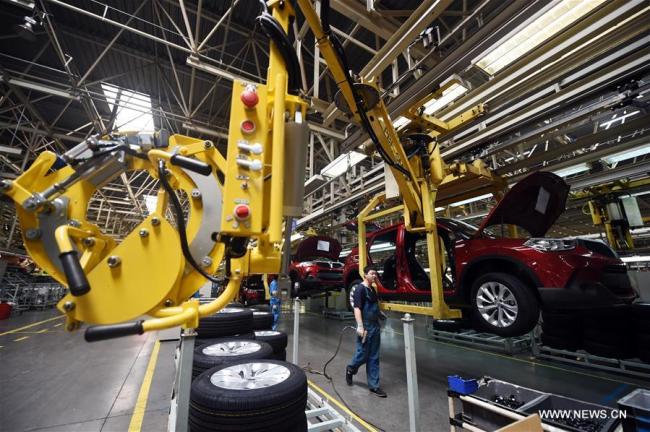
Workers assemble vehicles at the general assembly plant of Huachen Auto Group in Shenyang, capital of northeast China's Liaoning Province, June 10, 2015. (Photo: Xinhua)
China released its first quarter GDP numbers on Tuesday and results beat the forecasts of most economists. It saw its real GDP grow 6.8% YoY in Q1, the same as in Q4 2017, and this marks the 11th quarter in a row where China's real GDP has grown between 6.7 and 6.9 percent. In its release of numbers, the government also pointed out that both the jobless rate and inflation have remained stable suggesting that the overall economy remains healthy. Indeed, looking purely at first quarter performance it would appear that China's GDP is on track to match last year's growth, but a closer look suggests that the economy may be starting to slow and that the second and third quarters of 2018 might not be so strong.
First, the good news. In Q1 2018 retail sales stayed strong and increased 9.8% year on year. Maintaining strong consumer spending growth is hugely important to the overall resilience of China's economy when considering that China may be entering a trade war with the US which could have negative effects on exports, so seeing nearly double-digit growth in consumer spending over the first quarter is a good sign that people are optimistic and continue to have money to spend. Second, the jobless rate and inflation have both remained stable and within government targets which suggests that the economy is resilient and should not see a significant slowdown in spending on consumer goods this year. It also means that the government does not need to worry about enacting aggressive measures to convince consumers to spend which would undermine efforts to continue to reform the economy.
However, not all the economic news coming out of China is positive and there are a few indicators that do point to a gradual and significant slowdown in growth. While the jobless rate has remained low and consumer spending has remained robust, house sales have fallen off and house price growth slowed to its lowest level in two years in March, growing 4.9% YoY. While a slowdown in housing price growth by itself is not bad and can actually be a good thing for economic stability given exorbitantly high prices in Tier 1 and Tier 2 markets in China it does also indicate a lack of consumer optimism.
Additionally, while industrial output was strong in January and February, growing 7.2% YoY, growth fell to only 6% in March indicating potential issues for China's manufacturing sector for the rest of the year. A looming trade war possible with the US would put further pressure on industrial output and would be a very real drag on growth. This would be especially difficult as the government is going through a process of trying to reform old-style heavy manufacturing sectors as well as low margin manufacturing and the end result of a further slowdown would be a squeeze on factories and blue-collar workers which the government would have to account for in its spending plans. China will be looking at creative ways to ensure that manufacturing does not get hit too hard this year as it can no longer rely on government investment in infrastructure projects to shore up the economy.
The government also seems to be using 2018 as a year for strengthening the overall health of China's economy, even if it means accepting lower top line GDP numbers and this can be seen in the low investment coming from State Owned Enterprises. Because many of these companies carry significant debt and can also be a kind of proxy of the health of local governments there is pressure for them to back down on new investments which may be inefficient and instead work on paying down debt, so we should not expect to see heavy investment from SOEs this year. However, the good news is that last year private enterprises cut back heavily on their own investments in order to pay down debt and now in 2018 they have largely cleaned up their balance sheets and are investing heavily and taking up the slack for SOEs.
Despite the various indicators that suggest China may see a slowdown in economic activity and GDP growth next quarter, the economy remains resilient and the government is doing a good job of managing expectations. While GDP growth hit 6.8% in the first quarter the government previously forecast 6.5% growth for 2018 so the central government still has plenty of room to continue reforms without worrying about a slowdown in growth. The final takeaway from all of this is that even when facing a trade war, and high corporate debt levels China's economy remains strong and the government still has a fair amount of flexibility if needed to make sure that the economy remains stable.


